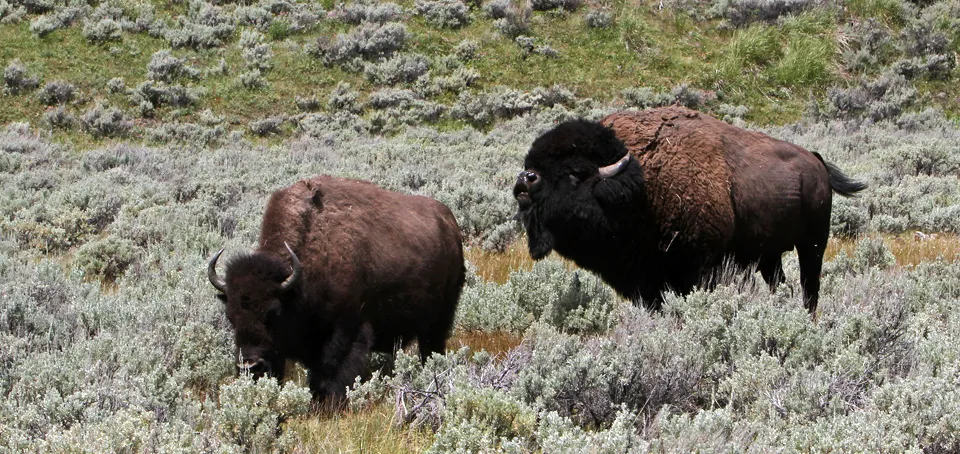Discover the incredible wildlife of America's first national park with expert tips and insider knowledge
Having spent over 15 years exploring and photographing wilderness areas, I can confidently say that Yellowstone National Park animals represent one of the most spectacular wildlife viewing experiences in North America. From my countless sunrise vigils in Lamar Valley to heart-pounding grizzly encounters, this comprehensive guide shares everything you need to know for an unforgettable wildlife adventure in America's premier national park.
Yellowstone's Big 5 Animals and Wildlife Overview
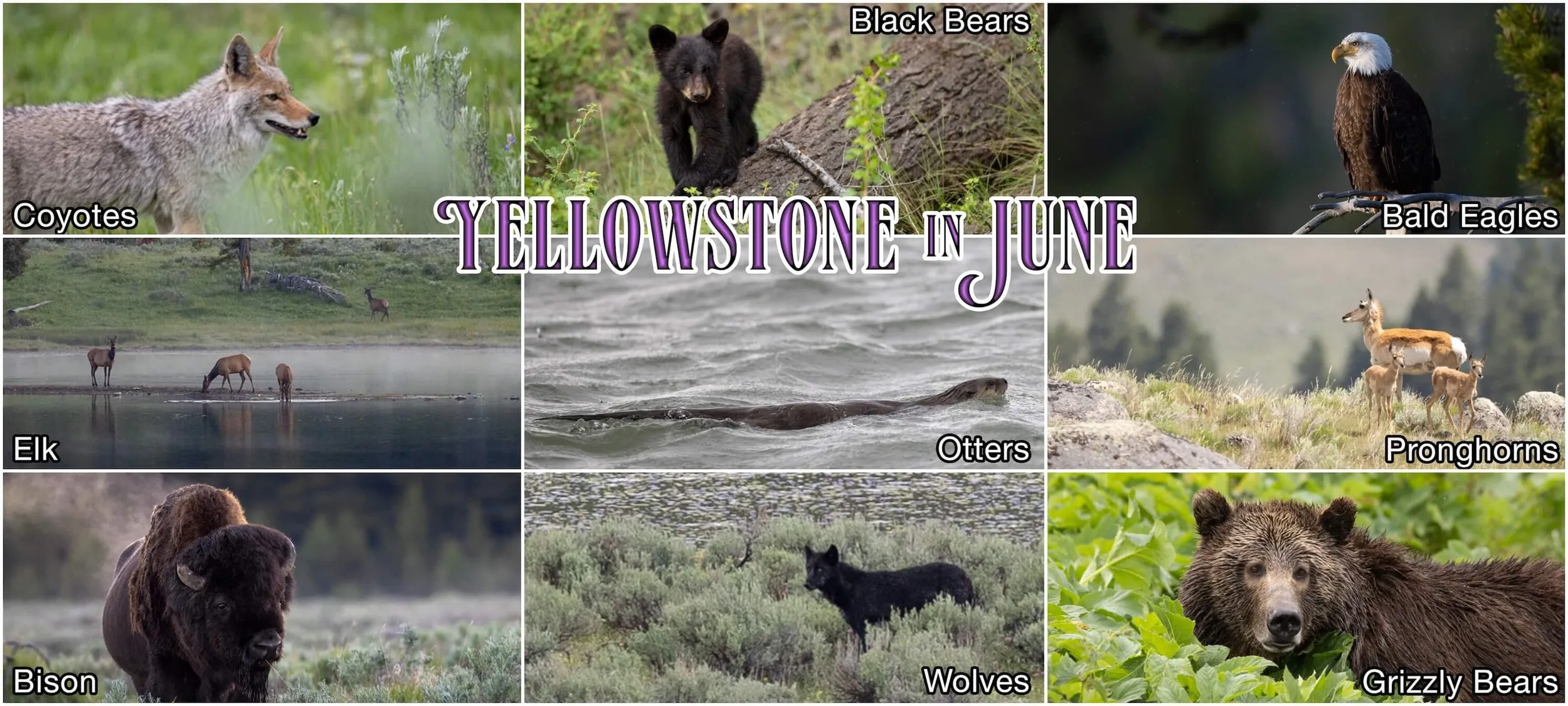
When I first started tracking Yellowstone National Park animals in 2008, I was overwhelmed by the sheer diversity and abundance of wildlife. Yellowstone hosts North America's largest concentration of mammals in the lower 48 states, with 67 mammalian species, nearly 300 bird species, and countless other creatures calling this pristine ecosystem home. The park's famous "Big 5" - grizzly bears, wolves, bison, elk, and moose - represent the crown jewels of Yellowstone wildlife viewing.
During my extensive research for facts about Yellowstone National Park, I discovered that this remarkable ecosystem functions as a complete predator-prey complex. The reintroduction of wolves in 1995 restored the natural balance, creating what scientists call a "trophic cascade" effect that has positively impacted everything from vegetation patterns to stream morphology.
The American bison, Yellowstone's largest mammal, can weigh up to 2,000 pounds and represents the only continuously wild population since prehistoric times. I've witnessed massive herds numbering in the hundreds, particularly in Hayden and Lamar Valleys. These magnificent creatures survived near extinction in the early 1900s when only 23 individuals remained in the park.
Grizzly bears, the park's apex predators, number approximately 150-200 individuals within Yellowstone's boundaries. During my encounters, I've observed their incredible intelligence and adaptability. Spring brings hungry bears emerging from hibernation, often visible on distant hillsides as they forage for roots, grasses, and carrion. The park's black bear population, estimated at 500-650 individuals, offers more frequent viewing opportunities due to their tolerance of human proximity.
Pro Tip: The best times to observe Yellowstone National Park animals are during the "golden hours" - the first two hours after sunrise and the last two hours before sunset when animals are most active and lighting conditions are optimal for photography.
Prime Wildlife Viewing Locations and Timing
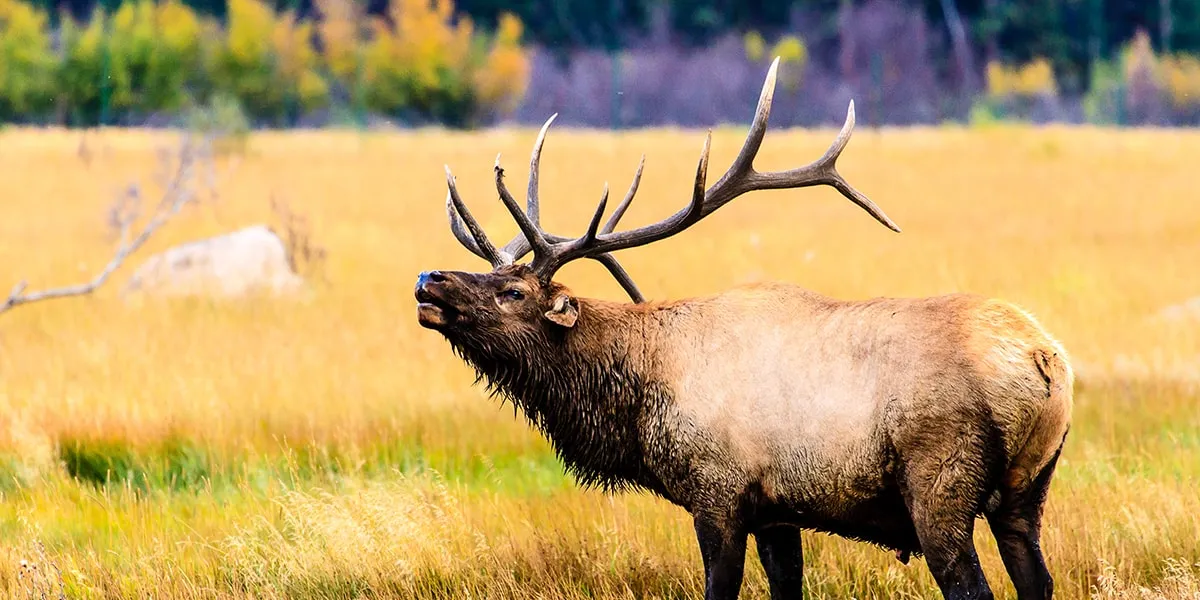
After documenting Yellowstone National Park animals across all seasons, I've identified several premier viewing locations that consistently deliver extraordinary wildlife encounters. Lamar Valley, dubbed "America's Serengeti," stands as the undisputed champion for wildlife diversity and frequency of sightings. This glacially-carved valley extends 7 miles east of Tower Junction and provides habitat for all major species.
My sunrise vigils in Lamar Valley have rewarded me with wolf pack hunts, grizzly bears fishing for cutthroat trout, and massive bison herds creating dust clouds visible for miles. The key to success lies in arriving before dawn and positioning yourself along the road between the Lamar River Bridge and Slough Creek Campground. Pack layers, hot coffee, and patience - the magic happens when you least expect it.
Hayden Valley offers equally spectacular opportunities, particularly for waterfowl, trumpeter swans, and great blue herons. The Yellowstone River meanders through this expansive grassland, creating perfect habitat for moose, elk, and both bear species. I recommend parking at the Hayden Valley pullouts and scanning with binoculars - animals often appear as distant dots that resolve into magnificent creatures through quality optics.
The Tower-Roosevelt area excels for bighorn sheep, black bears, and the famous Druid Peak wolf pack territory. Mount Washburn provides elevated viewing opportunities where I've spotted mountain goats, marmots, and soaring raptors. For those planning Yellowstone National Park tours, I always recommend dedicating full days to these premier locations rather than rushing between multiple sites.
Timing your visit significantly impacts wildlife viewing success. Early morning hours (6-9 AM) and evening periods (6-8 PM) provide optimal activity levels. Avoid midday hours when most animals seek shade and rest. Weather patterns also influence behavior - overcast days often extend activity periods, while sudden storms can trigger dramatic wildlife movements that create exceptional viewing opportunities for prepared observers.
Essential Safety Guidelines and Bear Awareness
Wildlife safety represents the most critical aspect of experiencing Yellowstone National Park animals responsibly. During my years photographing dangerous wildlife, I've witnessed numerous close calls that could have been prevented with proper preparation and awareness. The National Park Service mandates minimum distances of 100 yards from bears and wolves, and 25 yards from all other wildlife - distances I consider absolute minimums, not targets.
Bear encounters require specific protocols that have potentially saved my life on multiple occasions. Carry EPA-approved bear spray at all times and know how to use it effectively. The spray should be easily accessible - not buried in your backpack. When hiking in bear country, make noise, travel in groups of three or more, and remain vigilant for signs including tracks, scat, claw marks on trees, and partially consumed carcasses.
Critical Safety Alert: If you encounter a grizzly bear, do NOT run. Back away slowly while speaking in calm, low tones. Make yourself appear larger by raising your arms. If the bear charges, use bear spray when it reaches 30 feet, aiming slightly downward to create a defensive wall.
Bear Safety Equipment and Precautions
Professional-grade bear spray stands as your primary defense against aggressive wildlife. I personally carry SABRE Frontiersman, which offers maximum EPA-allowed potency and 30-foot range. The spray creates a wide defensive barrier that has proven effective in over 90% of documented bear encounters. Practice deploying the safety mechanism before entering bear habitat - seconds matter during real encounters.
Bison present unique dangers often underestimated by visitors. These massive animals can sprint 35 mph and jump 6-foot fences. I've observed tourists approaching within 10 feet of bulls during rutting season - behavior that could prove fatal. Bison warning signs include raised tail, pawing ground, snorting, and lowered head. If you see these behaviors, retreat immediately to your vehicle or substantial shelter.
Wolf encounters, while rare, require different strategies. Wolves typically avoid humans but may approach if habituated to food sources. Never feed wildlife or leave food unattended. If confronted by wolves, maintain eye contact, appear large, back away slowly, and make loud noises. Unlike bears, wolves may be deterred by aggressive posturing, but never turn your back or run.
Wildlife Photography and Equipment Recommendations
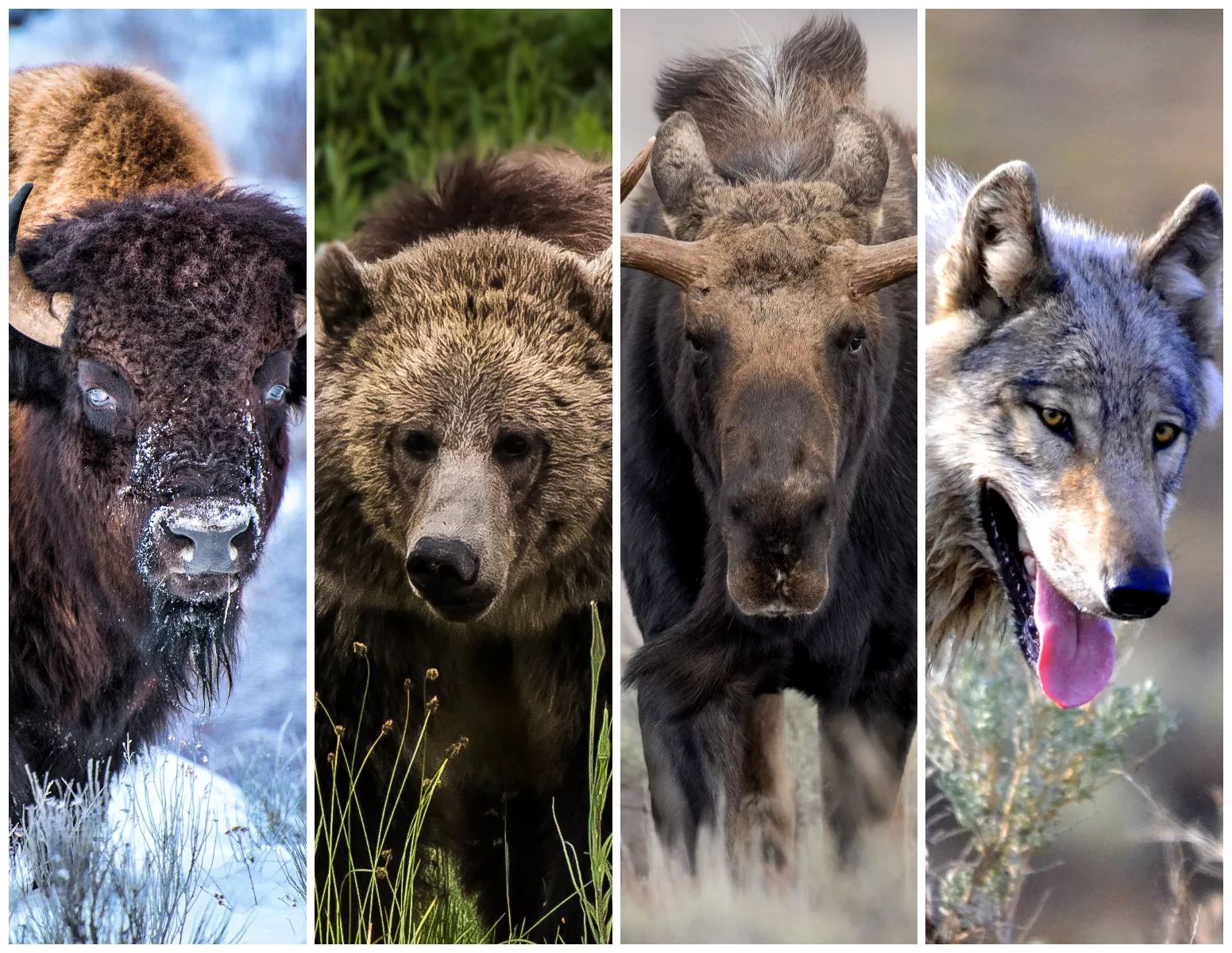
Photographing Yellowstone National Park animals demands specialized equipment and techniques I've refined through thousands of hours in the field. Long telephoto lenses (400mm minimum) are essential for maintaining safe distances while capturing intimate behavioral moments. My go-to setup includes a 600mm lens with 1.4x teleconverter, providing 840mm of reach for frame-filling shots of distant subjects.
Camera settings vary dramatically with lighting conditions and subject behavior. For wildlife action, I shoot in shutter priority mode with minimum speeds of 1/500s for stationary subjects and 1/1000s for running animals. Early morning and evening photography challenges your equipment's low-light capabilities - invest in cameras with excellent high-ISO performance (ISO 3200-6400) for usable results during prime golden hours.
Recommended Camera Equipment
Professional wildlife photography requires significant investment, but quality equipment dramatically improves success rates and image quality. Full-frame cameras offer superior low-light performance and better telephoto lens compatibility. Crop-sensor cameras provide additional reach through their multiplication factor - a 400mm lens becomes 600mm equivalent on APS-C sensors.
Tripods and monopods become essential for telephoto stability, especially during long observation periods. Carbon fiber construction offers the best strength-to-weight ratio for extended hiking. Gimbal heads provide smooth tracking for moving subjects while supporting heavy telephoto lenses without fatigue. Weather protection remains crucial - sudden storms and temperature fluctuations challenge both photographer and equipment endurance.
Fieldcraft skills matter more than expensive equipment. Study animal behavior patterns, learn to predict movements, and position yourself along likely travel routes. Patience rewards persistence - I've waited hours for perfect moments that last seconds. Understanding things to do in Yellowstone National Park helps identify optimal photography locations that align with wildlife activity patterns.
Seasonal Wildlife Behavior and Migration Patterns
Understanding seasonal variations transforms casual visitors into successful wildlife observers when experiencing Yellowstone National Park animals. Each season brings distinct behavioral patterns, migration movements, and viewing opportunities that I've documented through comprehensive year-round studies. Spring emergence (April-May) offers unparalleled excitement as hibernating animals awaken and newborns take their first steps.
Spring bear activity peaks during early May when sows emerge with cubs. I've observed families consisting of twins and occasional triplets, vulnerable and learning essential survival skills. Grizzly bears concentrate along streams where winter-killed ungulates provide crucial protein after months without food. Black bears venture into meadows for emerging vegetation, creating excellent photography opportunities against vibrant green backgrounds.
Summer months (June-August) bring peak tourist seasons but also incredible wildlife diversity. Elk herds migrate to higher elevations, following snowmelt and fresh vegetation. Wolf packs remain active throughout summer, raising pups in secluded den sites. Bison form massive aggregations in valleys, creating spectacular scenes reminiscent of historical Great Plains abundance. Bird diversity peaks with over 280 species documented during breeding season.
Autumn (September-October) delivers nature's grand finale through elk bugling season and preparation for winter survival. Bull elk gather harems of 15-30 cows, engaging in spectacular battles that echo across valleys. I've witnessed antler clashes lasting hours, with dominant bulls maintaining territories through constant vigilance. Bears enter hyperphagia, consuming up to 20,000 calories daily while preparing for hibernation.
Seasonal Planning Tip: Winter visits (December-March) offer unique opportunities to observe Yellowstone National Park animals adapted to extreme conditions. Bison use their massive heads as snowplows, wolves hunt in coordinated packs, and thermal features provide crucial wildlife refugia.
Winter transforms Yellowstone into a wildlife laboratory where only the hardiest species survive. Temperatures plummet to -30°F, testing animal adaptations developed over millennia. Elk migrate to lower elevations and thermal areas where vegetation remains accessible. Wolf pack dynamics intensify as prey becomes concentrated and vulnerable, creating dramatic predator-prey interactions visible to determined winter visitors.
Complete Species Guide and Identification Tips
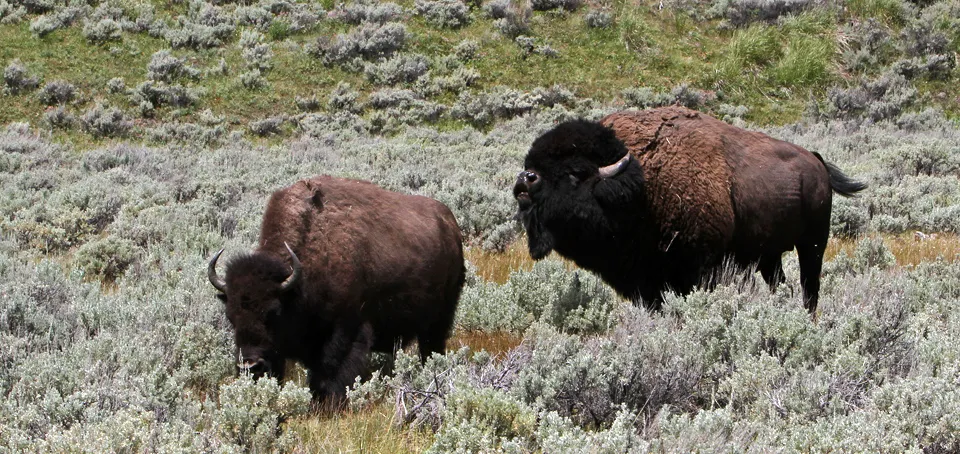
Comprehensive identification skills enhance every encounter with Yellowstone National Park animals by transforming fleeting glimpses into meaningful observations. Beyond the famous megafauna, Yellowstone supports an intricate web of smaller species that contribute essential ecological functions. Marmots whistle alarm calls from rocky outcrops, pikas gather vegetation for winter haypiles, and thirteen ground squirrel species create complex underground societies.
Predator identification requires attention to subtle details that distinguish similar species. Mountain lions, the park's largest cats, remain extremely elusive with estimated populations of 18-24 individuals. I've encountered fresh tracks but observed live animals only twice in fifteen years. Canada lynx, listed as threatened, inhabit dense forests where their oversized paws provide flotation in deep snow. Bobcats, more commonly observed, prefer rocky terrain and forest edges.
Ungulate diversity extends beyond the famous elk and bison. Moose, North America's largest deer, inhabit marshy areas and riparian zones where I've observed bulls with antler spreads exceeding six feet. White-tailed deer and mule deer occupy different ecological niches, distinguished by tail patterns, ear size, and gait characteristics. Pronghorn, technically not antelopes, represent evolutionary remnants capable of sustaining 60 mph speeds.
Avian diversity rivals any North American ecosystem with resident and migratory species creating seasonal spectacles. Trumpeter swans, North America's largest waterfowl, nest on remote lakes and represent conservation success stories. Bald eagles and golden eagles patrol thermals above valleys, while great gray owls hunt meadow edges during dawn and dusk periods. Sandhill cranes stage spectacular spring migrations through Yellowstone's wetlands.
Carnivore behavior patterns provide insights into ecosystem health and function. Wolverines, among North America's rarest mammals, inhabit remote high-elevation terrain where only dedicated researchers document their presence. River otters create playful spectacles along watercourses, while mink and marten pursue different hunting strategies in aquatic and arboreal environments respectively. For those interested in learning more about park wildlife, check out this stylish Yellowstone National Park t-shirt that celebrates the park's iconic animals.
Understanding animal tracks, scat, and sign interpretation transforms every trail into a wildlife story. Fresh grizzly tracks measure 9-12 inches in length with prominent claw marks extending 4-6 inches beyond toe pads. Wolf tracks show four toes with claw marks, larger than domestic dogs with more elongated overall shape. Developing these identification skills enriches every wilderness experience and contributes to citizen science monitoring efforts.
Conclusion
Experiencing Yellowstone National Park animals represents one of North America's premier wildlife adventures, offering unparalleled opportunities to observe complete ecosystems functioning as nature intended. Through my extensive fieldwork and documentation, I've witnessed the remarkable recovery of species once on the brink of extinction and the intricate relationships that define healthy wilderness areas. This guide provides the foundation for safe, responsible, and rewarding wildlife encounters that will create lifelong memories.
Success in wildlife viewing comes from preparation, patience, and respect for the animals that call Yellowstone home. The investment in quality equipment, safety gear, and education pays dividends through enhanced experiences and improved safety margins. Remember that we are visitors in their domain, and our behavior directly impacts both individual animals and ecosystem health. Every encounter should leave wildlife undisturbed and natural behaviors intact.
The future of Yellowstone National Park animals depends on continued conservation efforts, scientific research, and public support for wilderness protection. Climate change, habitat fragmentation, and human development pressure challenge traditional wildlife management approaches. By supporting responsible tourism, conservation organizations, and evidence-based policies, we ensure future generations can experience the same wonder and inspiration that drew us to this remarkable landscape.
I encourage every visitor to approach Yellowstone with curiosity, humility, and deep respect for the natural world. The animals you encounter represent millions of years of evolutionary adaptation and deserve our protection and admiration. Whether you glimpse a distant wolf pack or watch bison grazing in golden evening light, these moments connect us to something larger than ourselves and remind us why wilderness conservation matters.
For comprehensive trip planning and additional resources, visit our detailed guide to Yellowstone National Park animals and discover everything this incredible ecosystem has to offer. Your adventure in America's first national park awaits - prepare well, stay safe, and embrace the magic of wild Yellowstone.
Ready to Plan Your Yellowstone Wildlife Adventure?
Equip yourself with the essential gear for safe and successful wildlife viewing

